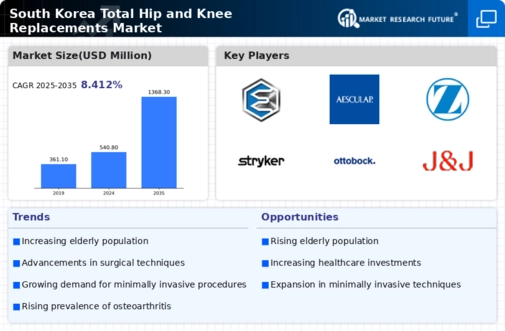Advancements in Surgical Techniques and Technologies
Innovations in surgical techniques and technologies are transforming the total hip-knee-replacements market. Minimally invasive procedures, robotic-assisted surgeries, and enhanced imaging technologies are becoming increasingly prevalent in South Korea. These advancements not only improve surgical outcomes but also reduce recovery times, which is appealing to both patients and healthcare providers. For instance, the adoption of robotic systems has been shown to enhance precision during surgeries, potentially decreasing complication rates. As these technologies become more accessible, the market is expected to witness a surge in demand, as patients seek out facilities that offer the latest advancements in joint replacement procedures.
Rising Healthcare Expenditure and Insurance Coverage
In South Korea, rising healthcare expenditure is a significant driver for the total hip-knee-replacements market. The government has been increasing its healthcare budget, which has led to improved access to surgical procedures for patients. Additionally, the expansion of insurance coverage for joint replacement surgeries has made these procedures more affordable. Recent data indicates that around 70% of the costs associated with total hip and knee replacements are now covered by national health insurance. This financial support encourages more patients to opt for surgical solutions, thereby propelling the growth of the total hip-knee-replacements market as more individuals seek treatment for debilitating joint conditions.
Aging Population and Rising Incidence of Joint Disorders
The aging population in South Korea is a primary driver for the total hip-knee-replacements market. As individuals age, the prevalence of joint disorders such as osteoarthritis increases significantly. Reports indicate that approximately 30% of the elderly population experiences some form of joint pain, leading to a higher demand for surgical interventions. This demographic shift is expected to continue, with projections suggesting that by 2030, over 20% of South Korea's population will be aged 65 and older. Consequently, the total hip-knee-replacements market is likely to expand as healthcare providers seek to address the needs of this growing segment, ensuring improved mobility and quality of life for older adults.
Growing Focus on Quality of Life and Patient Satisfaction
There is an increasing emphasis on quality of life and patient satisfaction in South Korea, which is driving the total hip-knee-replacements market. Patients are becoming more informed about their treatment options and are actively seeking procedures that promise better outcomes and enhanced mobility. Healthcare providers are responding to this trend by prioritizing patient-centered care, which includes thorough pre-operative consultations and post-operative support. Studies suggest that patients who undergo joint replacement surgeries report significant improvements in their quality of life, with satisfaction rates exceeding 90%. This focus on patient experience is likely to stimulate demand for total hip-knee-replacements, as more individuals recognize the benefits of surgical intervention.
Increased Research and Development in Orthopedic Solutions
The total hip-knee-replacements market is being propelled by increased research and development in orthopedic solutions. South Korea is home to several leading medical research institutions and companies that are dedicated to advancing joint replacement technologies. Ongoing studies are exploring new materials, implant designs, and surgical techniques that could enhance the longevity and effectiveness of joint replacements. For example, the development of biocompatible materials is expected to reduce the risk of implant rejection and improve patient outcomes. As these innovations emerge, they are likely to attract investment and interest in the total hip-knee-replacements market, fostering a competitive landscape that benefits patients and healthcare providers alike.

















Leave a Comment